In the issue 08/22 of the German Javamagazin you can read my latest article about the future of Agile.
You can read it also online on entwickler.de.
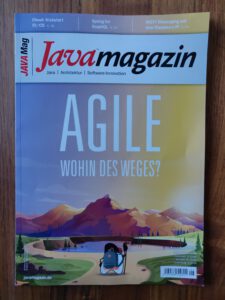
Enjoy the read.
In the issue 08/22 of the German Javamagazin you can read my latest article about the future of Agile.
You can read it also online on entwickler.de.

Enjoy the read.
From 8.November 21 to 12.November 21 W-JAX is taking place in Munich. W-JAX is the winter version of JAX, which is the leading conference for professional software development in Germany. This year W-JAX will be hybrid, that is people can attend personally or online from whereever they are.
I have the pleasure to moderate this years agile day again. The main topic of the day is agile beyond development. Many organisations are applying agile frameworks and techniques with good results. But business agility is often not achieved. That’s why we have choosen inspiring sessions about agility at the business level.
My session is about Kanban Flight Levels and OKRs. I am going to show how to establish coordination and alignment levels on top of agile teams.
The last session will be an interactive lean coffee session in which you can bring in and discuss your own topics.
I am looking forward to this great conference day and hope to meet you there.
In 2021 many organisations are trying to become more agile. They do that by applying techniques such as Scrum or Kanban. In the articles I wanted to shed some light on more hidden aspects of cultural development which I think is the real success factor of agile organizational development.
Recently I published a series of articles about agile culture development in the German IT magazines Java Magazin and Windows Developer.
Those are the Java Magazin issues that contain the article:


I am glad to see that this time the article was published in two magazines. Those are the Windows Developer magazines.

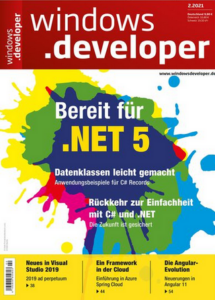
If you are interested in the content, please visit entwickler.kiosk, or even better, get in touch with me so that we can talk personally about agile culture development in your organisation. 🙂
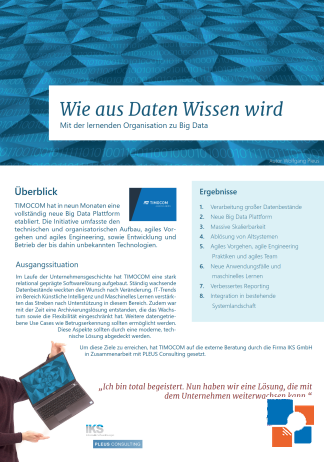 |
In the years 2019 and 2020 I had the pleasure to support TIMOCOM in the implementation of their brand new Big Data Platform. When we started the initiative the company had an existing BI-System to perform reporting and statistical analysis. The aim was to extend the capapabilities of the company to collect, store and analyse huge amount of data. A Big Data solution comprising best of breed open source products was chosen. The new technology stack is able to scale not only technically but also business wise as it ist completely license cost free. It is based on technologies such as Java, Python, Hadoop, Hive, Kafka, Spark and HBase. The new platform enables the company to gain new insights from their data today an tomorrow. It is an important step in the future to support their data driven business model. |
Thank you for attending my sessions at JAX 2019. The slide decks and source code can be downloaded here:
Resilienz, Skalierbarkeit, Performance – über die Architektur agiler Produktteams
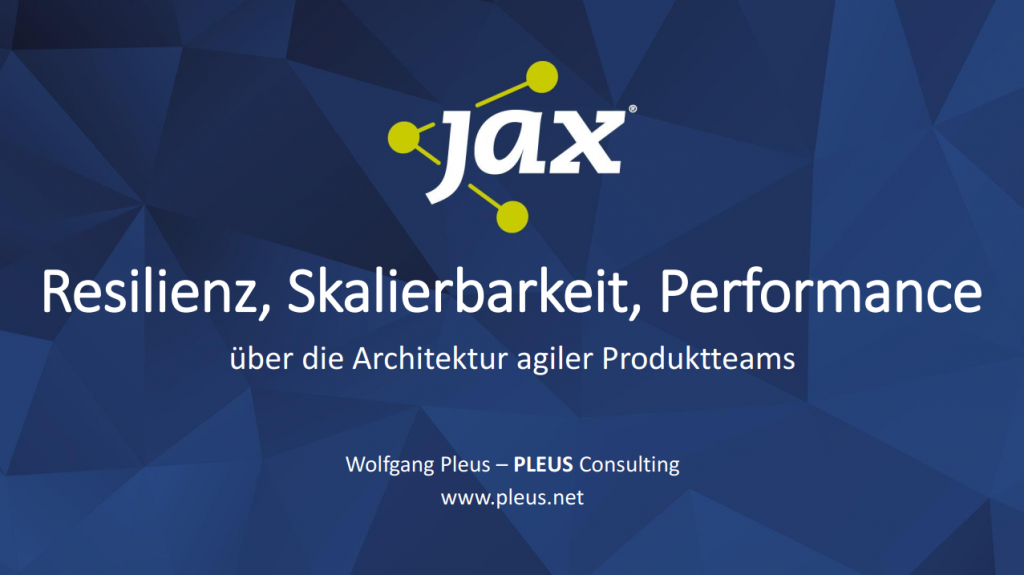

The video of my JAX 2018 session Lösungen in Rekordzeit: Scrum im Kontext von klassischem Anforderungsmanagement is now online on JAX TV.
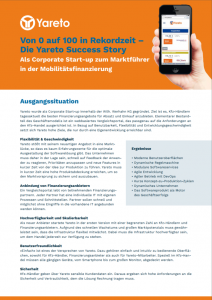
|
In 2017 PLEUS Consulting supported Yareto GmbH in the development of their new independent comparision site for the automotive finance industry. Yareto is a fintech company that specializes in automotive financing. In 2016 the corporate startup was founded to build a brand new comparision site for the automotive finance industry. The site enables car dealers to compare credit offers in the areas of sales financing and purchase financing. Lenders get access to sales channels they couldn’t serve before. PLEUS Consulting supported Yareto in setting up a Creative Software Workbench. The Creative Software Workbench aligns technology, processes and people in a way that creates an environment in which high quality digital products can be developed in short time. The front-ends were developed using modern web technologies such as Java-/Typescript, HTML5, CSS and Angular. For the backend Java Enterprise (JEE) and a Sustainable Service Design approach was utilized to design and build a backend with a high degree of reuse and scalability. The service landscape was established using Domain Driven Design principles. Operations was performed using cloud platforms. On the technical side, PLEUS Consulting supported the teams as Lead Developer. In the area of agile techniques, PLEUS Consulting supported the development teams as Agile Coach. The combination of those roles worked quite well especially in the phases of seed and growth. With these roles the company received thorough support in the areas of technology and methodology. The project has shown that with a combination of modern technologies, agile approaches and the right people a very short concept to market cycle can be achieved, creating competitive advantages. This is what the Creative Software Workbench is all about. |
You can read more details about the project in the official success story. More info about the Creative Software Workbench can be found on the official website.
The video of my JAX 2017 session Agilität: Mythen, Trends und Best Practices is now online on JAX TV.
People are born with an agile mindset. Many of them lose it throughout their career as they are shaped by an industrial culture which is based on ideas like the lone warrior and error avoidance.
Establishing an agile mindset amongst the team members is a challenging task, especially in non-agile organisations. Behaviours and habits which have been appropriate for many years have to be unlearnt and replaced by new behaviours. Many Scrum Masters and Agile Coaches, including me, work with posters explaining the principles of Scrum, Lean, etc. While these posters are helpful, they are a bit limited as they only show abstract principles. To apply these principles, people must transfer them to specific actions, which is sometimes difficult. To make this step easier I have created the Agile Culture Cards. These cards address certain behaviours directly and offer alternatives. They are close to the reality of the workplace and thus make it easier to understand and apply agile principles.
You can download a deck of Agile Culture Cards from the download section. The cards are currently available in German only.
Agile Culture Cards intend to train an agile mindset on a daily basis.
Feel free to use them as you like. If you have any ideas for more cards please let me know so that I can include them in the next version.
The Broken Windows theory was developed in 1982 in the US in the area of crime prevention. The theory describes norm-setting effects of urban disorder. Simply put, it means that if the windows of a building are broken the likelihood of further broken windows increases. This is a metaphor to stress that environmental and cultural settings have a huge impact on the behavior and norms of people.
For instance, if one window is already broken and nobody cares about it, it seems to be acceptable to break other windows as well. Broken windows encourage people to break windows. If all the windows of a building are intact, the inhibition threshold to break windows is much higher. Although the theory was developed in the domain of criminology, it can also be applied in software development projects. I am sure everyone working in IT already knows about broken windows.
Examples of broken windows on a technical level are:
As broken windows produce more broken windows over time the software might become harder and harder to maintain which sometimes requires a complete rewrite after a few years.
How can broken windows at the technical level be fixed and avoided?
One way is to understand that not just functional misbehavior in applications, e.g. the inability to save customer data, is treated as an error. Violating design principles and coding conventions should also be treated as errors which have to be fixed as soon as possible. These errors are usually not detected by functional testers but by developers themselves and their colleagues. If a developer spots a violation, he/she should create an issue in the bug tracking system. Over time the code quality increases and broken windows are repaired. A culture of constructive criticism helps to foster this.
At the level of agile methods examples are:
Over time the development process might deteriorate and create fewer and fewer predictable outcomes.
What can we do to prevent that?
It is important to address misbehavior when it happens. Do not wait until it becomes normal and is replicated by other team members. Just like a scrum master teaches the team the value of the scrum principles and artefacts and guides them on their way to an agile mindset. Mature agile teams are able to address broken windows for instance during their retrospectives.
People in software development teams are prone to the broken window effect as they do not work in isolation. They align their behavior to the accepted principles of the group. If the group includes bad role models and shows misbehavior or a bad coding style (both are broken windows) the team is likely to follow. After a while the code smells and bad habits become normal (although it doesn’t smell anymore ;-)). Broken windows produce more broken windows even when they don’t produce any immediate problems. Therefore, it is important to fix them as soon as possible. If not, the likelihood of code- or team-erosion increases. If broken windows are fixed on time, the teams and codebase can maintain a high level of quality which is required to deliver software quickly and reliably.
Keep improving…